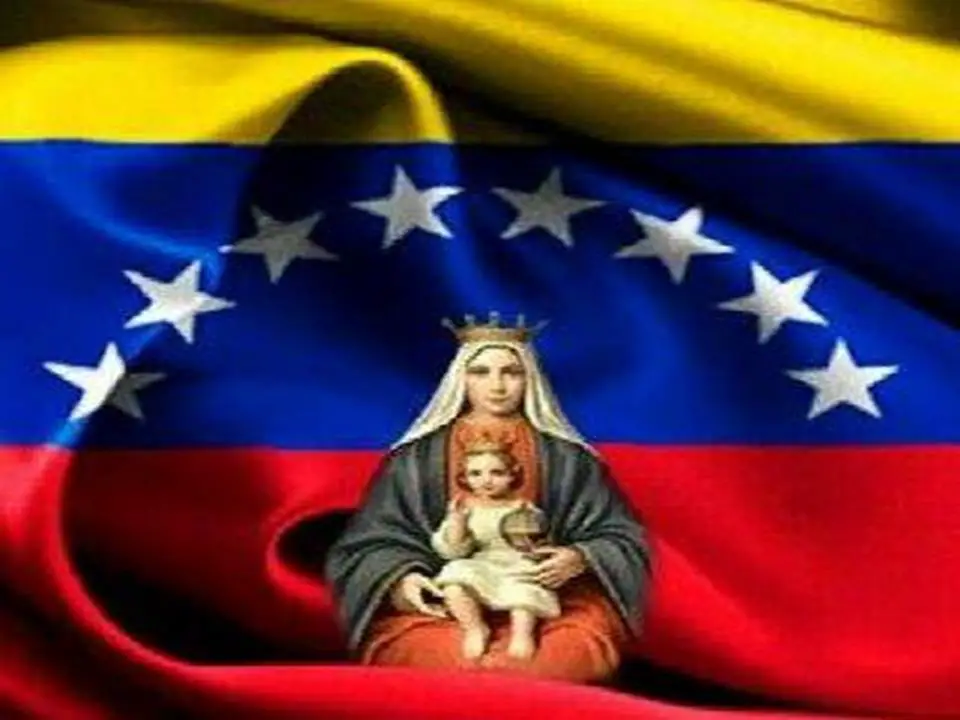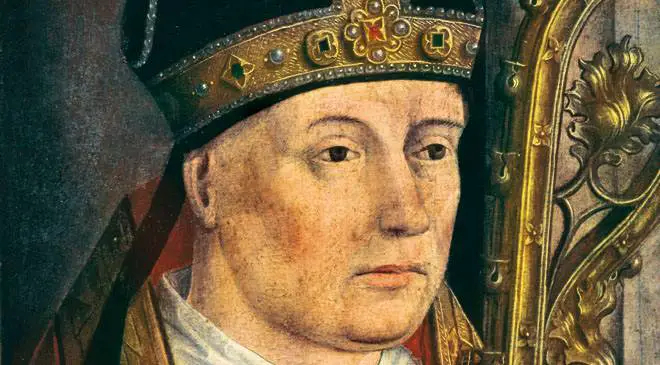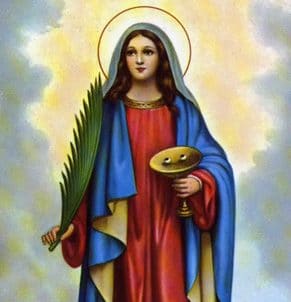Kadampa Buddhism is a tradition of Mahayana Buddhism founded by the great Indian master Atisha in 982-1054. Kadampas integrate all of the Buddha’s teachings into their knowledge as a fundamental part of their daily lives.

What is Kadampa Buddhism?
Breaking down the word Kadampa, we have that Ka refers to all the teachings of Buddha, the Dham, the 21 special stages of Lamrim, the path to enlightenment taught by Atisha, and Pa, the true and sincere practitioner of these 21 stages or meditations.
This means that Kadampa practitioners integrate their knowledge of all the Buddha’s teachings by applying the 21 stages of Lamrim to every circumstance of their daily lives. In this way they can transform their activities and facilitate the path to enlightenment.
Kadampas Masters
These masters were famous for being great scholars as well as pure and sincere spiritual practitioners. They focused on training the mind through practices that could transform all the experiences of daily life, and especially the problems, sufferings and difficulties that arise on the spiritual path.
This practice spread after Atisha through a succession of teachers such as Dromtompa, Geshe Potoua, Geshe Sharaua and Geshe Chekhaua.
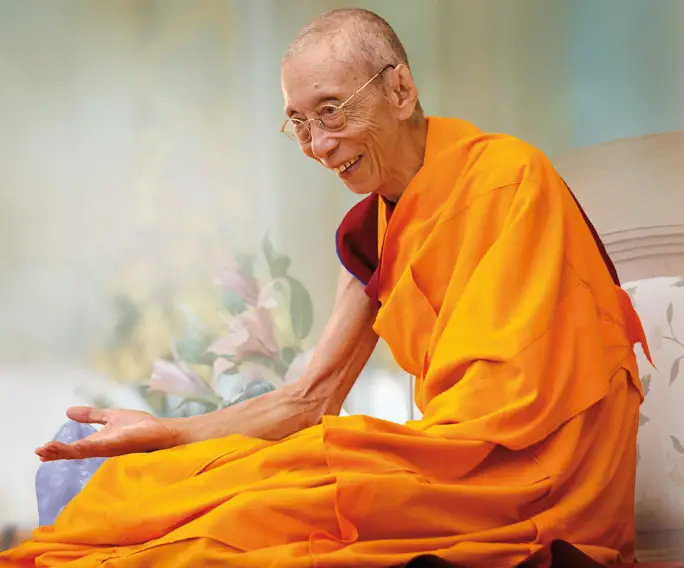
New Kadampas
The Kadampa Lineage had been handed down since the 14th century until the arrival of the Buddhist master Yhe Tsongkhapa. He clarified and simplified the Kadampa Dharma teachings to make them accessible to all the people of his time.
In particular, he combined Lamrim and Loyong with Mahamudra Tantra to do the daily practices in a unified way. This union of study and practice was what characterised the early Kadampas, and the union of Sutra and Tantra was the new Kadampas, the term by which the followers of Yhe Tsongkhapa are known (See: Tantric Buddhism).
Modern Kadampa Buddhism
After Tsongkhapa, Kadampa Buddhism was greatly propagated and flourished throughout the world by the contemporary Buddhist master Geshe Kelsang Gyatso. He was responsible for establishing the International Union of Kadampa Buddhism, creating a global infrastructure to preserve and promote Kadampa Buddhism throughout the world and for future generations.
The new Kadampa Tradition was born in England in 1991 under the guidance of Tibetan monk Geshe Keksag Gyatso, based on very ancient teachings and texts. Up to that point there was nothing new; the problem arose with its followers, most of whom were Westerners.
This tradition was consolidated in Europe as a religious movement whose foundations were opposed to Tibetan Buddhism and which emerged as a result of the leadership gained by the political and religious leader, the Dalai Lama.
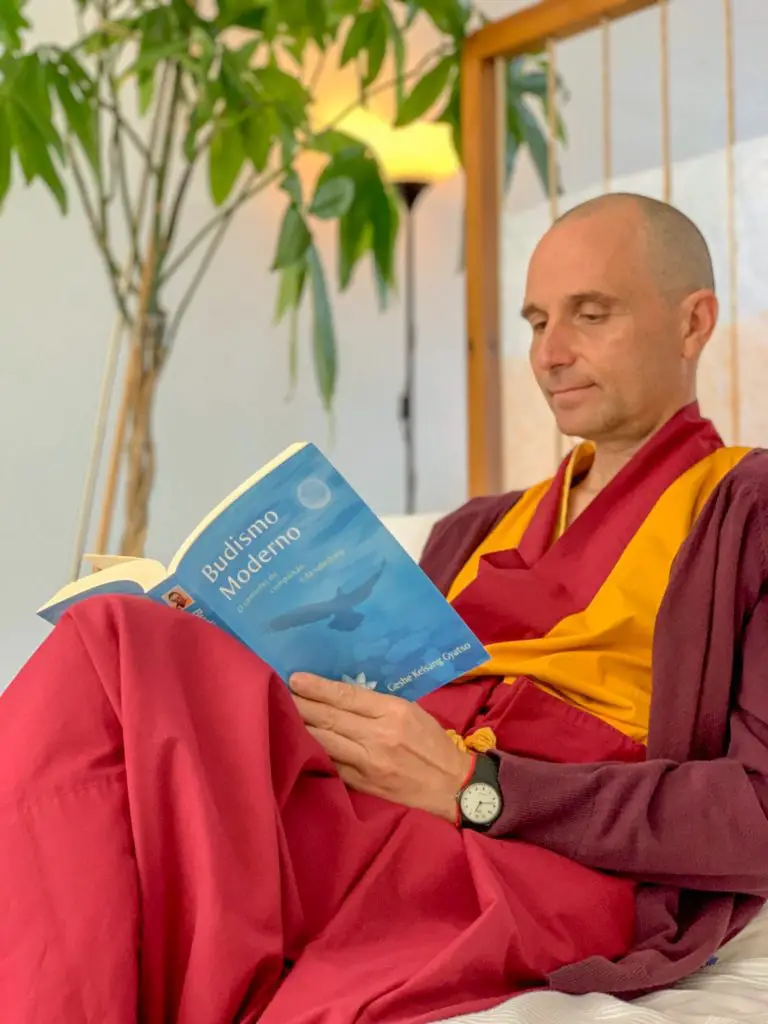
In the face of public denunciations, both national and international, by the followers of this new Kadampa against the main spiritual leader of Tibet, saying that he was a dictator, inhuman, greedy and other denigrating behaviour, a movement began against them, accusing them of being liars and perverters of Tibetan Buddhist doctrine.
Meanwhile, the Dalai Lama has taken it upon himself to discredit such a movement, even declaring that the practice of Shugden used in this Kadampa tradition is wrong and false outside of any religious context. He went on to say that no true Buddhist could have anything to do with this teaching.
Thus a doctrinal confrontation arose between these two monks over the interpretation of their religious culture. This does not affect the worldwide practice of Buddhism, bearing in mind that even if Tibetan Buddhism is the most popular in the West, this does not mean that it is the most representative and popular in the world (see article: Meditation in Tibetan Buddhism).
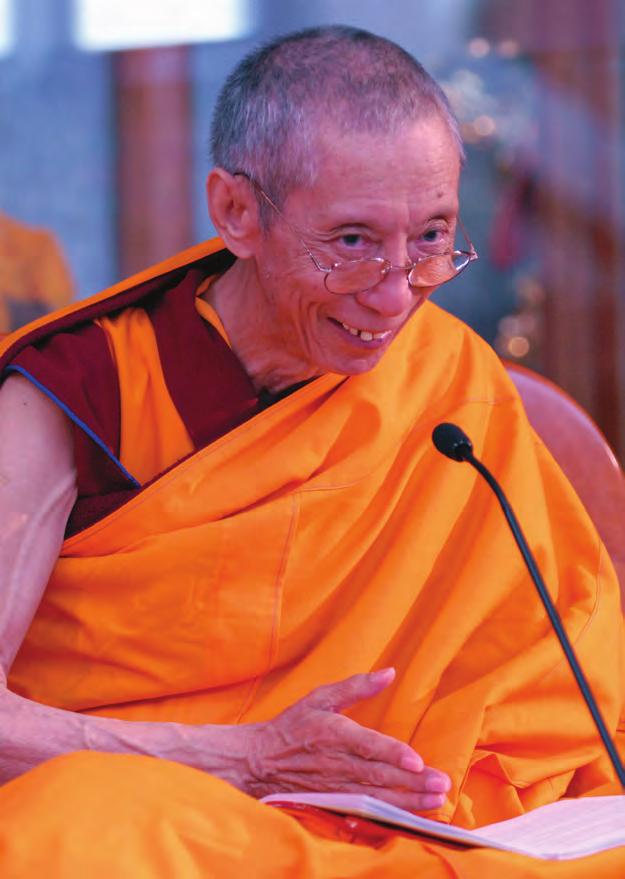
Venerable Gueshe Kelsang Gyatso Rimpoché
Dalai Lama
But there is one important factor affecting Buddhism in this new tradition, and that is the political factor. Ever since China occupied Tibet more than 60 years ago, the Dalai Lama has been a thorn in the side of the mainland Chinese Communist government. He has taken it upon himself to expose the brutalities of Chinese occupation – political, religious, social, cultural and more – to free democracies and Western powers.
This provoked protests and diplomatic demands from the Chinese government every time this monk won a diplomatic victory by exposing the manoeuvres and abuses of the Chinese communists in Tibet.
Tenzin Gyatso (the Dalai Lama) is to the Chinese Communists what Pope John Paul II was to the Soviet Russians, who was a real obstacle to Russian Communism during the Cold War. Pope John Paul II is said to have been a decisive factor in the fall of Soviet communism in the 1990s.

However much they have tried to counter the Dalai Lama’s devastating attacks in international fora with political and propaganda strategies, they have failed to do so, and on the contrary have made the Tibetan monk’s denunciations even more prominent, which has led him to gain more sympathisers in the West.
Some believe that this new Kadampa tradition is nothing more than a frustrated attempt by the Chinese government to discredit the Dalai Lama, their main ideological enemy.
For many years they have tried to use Buddhism itself against the monk, using images of people looking like monks, with shaved heads, wearing Tibetan robes, and holding up placards with insults and curses, to highlight alleged criminal acts committed by this leader.

Dalai Lama
Kadampa Temple
The first Kadampa Temple was built on 1 August 1997, with a design based on the mandala of Heruka Buddha, known as the Buddha of Compassion of Supreme Yoga Tantra. From these features it is easy to see that this is no ordinary building (see article: Buddhism and Yoga).
The temple consists of four gates and eight auspicious symbols around them. Above each of the gates are two deer and a Dharma wheel, and on the roof is a golden vajra with five points, indicating the qualities that make it a holy place.
What do the four gates symbolise?
They symbolise the four gates of liberation, i.e. the four types of wisdom realisations described in the Essence of Vajrayana. These four gates lead the way to permanent liberation from suffering.
Similarly, they are the four faces of Heruka, which teach that if we want to achieve permanent liberation from suffering, we must pass through the four gates, which is the spiritual path, and therefore at least one of them must be passed through.
When you enter the temple, you think: “Now I am entering the gate of the path that leads to liberation”, thus creating a special karma in one’s mind.
According to the Sutra, there are three gates of liberation, but for the Supreme Yoga Tantra there are four.
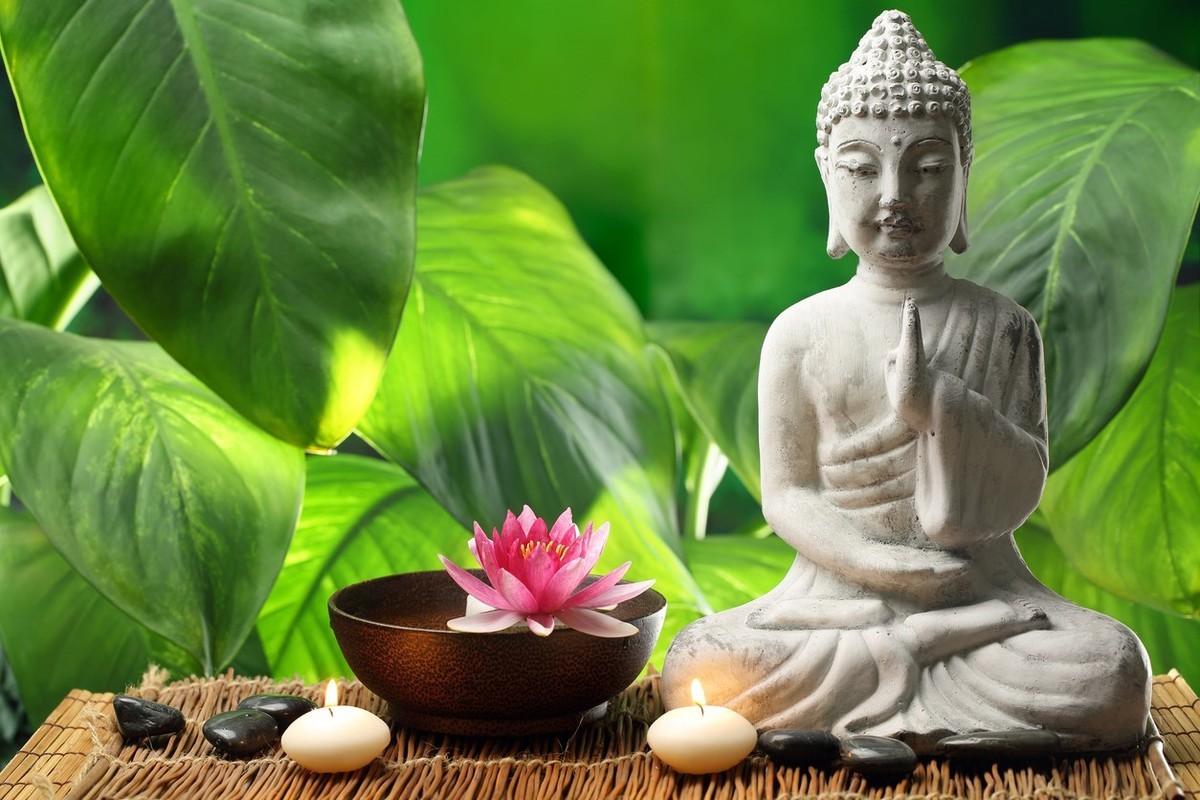
Eight auspicious symbols
There are eight auspicious symbols around the temple, which show how we should progress along the Buddhist path to the desired enlightenment:
The precious umbrella
This symbolises the Buddhist community and teaches those who wish to progress on the Buddhist path to enlightenment that they must join the Buddhist family, take refuge in the Three Jewels and become a Buddhist.
In other words, in order to progress on the path to enlightenment, they must enter Buddhism, outside of which they will not be able to do so. When you enter, you must begin to go through the stages of this path, progressing month by month, year by year, and completing each one.
The Precious Fish
These fish symbolise peace and harmony and teach that one should always live in peace under the precious umbrella. It is not only in the Buddhist community that harmony and peace should be achieved in the family, but also in all other communities and societies, large and small.
The two fish playfully demonstrate that they are happy and live in peace and love, setting an example that if they can do it as animals, so can we as human beings.

The precious vessel
It symbolises wealth and also teaches Buddhist practitioners to always enjoy the inner wealth of faith, discipline, Dharma study and practice, helping others, honour, compassion and wisdom.
These are the seven essential riches that a person must possess. Buddhists believe that the greatest wealth is inner wealth, even more than material wealth, money and external goods or conditions. Such wealth makes us happy in every time and space, and helps us in this life and in future lives.
Faith in the holy Dharma
This belief calms, purifies and pacifies our mind so that everything is perceived as pure. We cease to have problems because our mind is pure, as are our perceptions. When the mind is impure, the body is angry, jealous, with false visions, everything is perceived in a negative way and we find it unpleasant. Criticism, arguments, quarrels and disharmony arise.
Moral Discipline
Faith makes the mind pure and through faith we become pure beings. Faith in the holy Dharma and the practice of moral discipline make our physical and verbal actions pure. Thus we become pure and holy beings.
Dharma study and practice
This is the most important wealth, because knowledge is very beneficial. It protects us and others and teaches us everything we need to know.
Helping others
When we help others, whether by offering material things, Dharma teachings, love, protection or any other kind of help, we are in the presence of the greatest heart wealth, wonderful inner qualities.
Honour
This is a special inner quality that makes us think: “I cannot do this harmful action because I am a Buddhist, a practitioner and so on”, “I cannot kill people because I am also a human being”, “I cannot end the spiritual life and happiness of others because I am a spiritual practitioner”, this is something very precious and special.
We must not forget that there are people who kill, destroy and do a lot of damage because they lack honour. The sense of honour is therefore a great inner richness that allows people to become special beings.
Consideration for others
When we have compassion, we think like this: “I cannot do harmful actions because I will make others suffer. I cannot harm others because they will suffer”, “I cannot kill that person because they will experience suffering”, “I cannot steal from that person because I will cause them problems”, “I cannot harm others because their happiness is as important as mine”, which shows that we are always thinking of the good of others. This is also a great inner spiritual wealth.
Wisdom
We can use it everywhere and in every situation. It cannot be stolen by thieves; it is a faithful friend, always ready to help us.
It teaches us what to do and what not to do, with wisdom we do not need to ask others for advice, it will show us the ideal path, the direction we should take, always in our favour.
We must enjoy human happiness, but reduce the sense of attachment; if we enjoy the inner wealth, we will always be happy and secure.
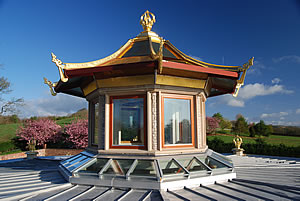
The precious flower
Represented by the lotus flower, itself a symbol of purity. We must practise the bodhisattva way of life to become pure beings by cultivating and strengthening a good heart through actions similar to those of a bodhisattva. The lotus indicates that we cannot be impure and ignorant beings, that we must strive to be pure, and that such a lifestyle can be achieved (see article: Buddhist Culture).
The precious conch
This conch symbolises the Dharma Jewel, which teaches the need to attain the realisations of the stages of the path to enlightenment. With these realisations we protect ourselves from suffering and problems in a direct way.
The Precious Knot
The knot of eternity represents an extraordinary quality, that of the omniscient wisdom of the Buddha’s realisation.

The flag of precious victory
This flag symbolises the extraordinary quality of renunciation when detached from its mental disturbances and false appearances.
With these two symbolic figures, the knot and the flag, it follows that when one attains the Dharma Jewel, that is, the realisation of the stages of the path to enlightenment, one attains these two excellent and extraordinary qualities of the Buddha.
The Precious Wheel
By attaining these two qualities of the Buddha, one can lead other beings to permanent liberation from suffering, especially by turning the wheel of the Dharma, that is, by passing on the teachings of the Dharma, which is the ultimate goal.
These eight auspicious symbols teach and remind us to put their meanings into practice and integrate them into our daily lives.
The Deer, the Wheel of Dharma and the Vajra
Above each of the entrances or gates are two deer and a Dharma Wheel. On the roof of the temple is a vajra, all of which symbolise the stages of the supreme yoga-tantra path. Together with the eight auspicious symbols we follow the path to enlightenment, the Buddhist path in general, and the deer, the Dharma wheel and the vajra show the stages of the path of Highest Yoga Tantra.
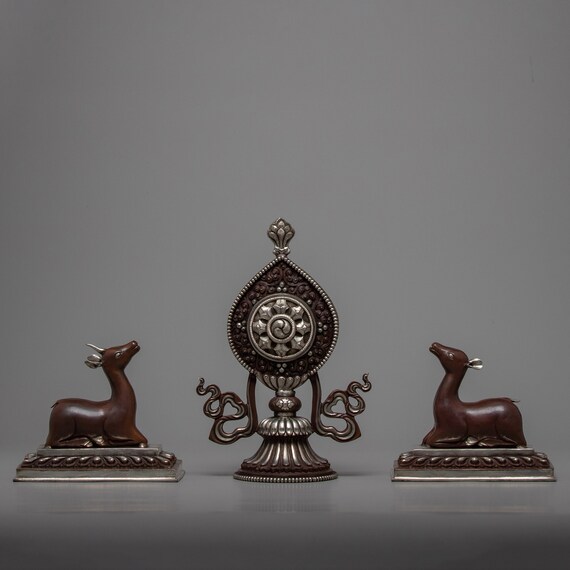
The deer in particular symbolises the realisation of great bliss, while the doe, the realisation of emptiness, and the Dharma Wheel symbolise the union of the two. By progressing in this union, great bliss and emptiness, one attains the five omniscient wisdoms of the Buddha, symbolised by the five-pointed vajra.
In conclusion, the temple symbolises the following: if we progress according to the practice shown by the eight auspicious symbols and then follow the extraordinary path of supreme yoga tantra, that is, the union of great joy and emptiness, we can attain the five omniscient wisdoms of a Buddha. This is why this temple is not an ordinary building, but a holy temple.
Tibetan Buddhism
Tibetan Buddhism is the Buddhism that developed in the Himalayas. It is also known as Lamaism, Vajrayana Buddhism and Tantric Buddhism. Followed by only about 6% of Buddhists, it is one of the most widely practised and best known schools in the West.
It is predominant in Bhutan, Mongolia, Ladakh (India) and Tibet, and there are significant Lamaist Buddhist minorities in Sikkim (India), Nepal and the ethnic Mongolian regions of Russia, such as Buryatia, Kalmukia and Tuva, and Inner Mongolia (China).
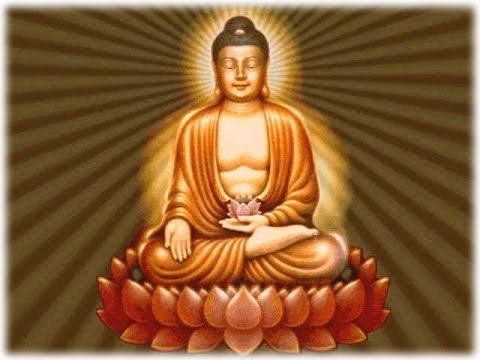
This religion is particularly prevalent among the Mongolian and Tibetan peoples, who recognise the Dalai Lama as a Bodhisattva and therefore respect him as a spiritual master of great importance. Although the different schools have their own hierarchy and teaching systems.
With more than 20 million followers worldwide, it is considered one of the largest branches of Buddhism, as well as one of great relevance and importance.
The figure of the lama is associated with this type of Buddhism as someone of religious, social and economic importance in Tibet.

Mahāyāna Buddhism
Mahāyāna Buddhism was introduced to Tibet in the 8th century by the Indian guru Padmasambhava. Before him there was an animistic and magical religion known as Bön. When Buddhism arose and reached an important peak, the Bön religion did not disappear, but a transformation of the religion began.
Some of the Bön beliefs also influenced Tibetan Buddhism. The Mahāyāna tradition, also called the Great Vehicle, seeks not only personal liberation but also the liberation of all sentient beings, for which one must attain the state of Buddha.
Tibetan Buddhism developed rapidly with the influx of Tantric teachings from northern India, which spread to Tibet, Sri Lanka, China and elsewhere. This teaching was associated with the Buddhism called Vajrayāna or Tantric Buddhism, which even in the West is mistakenly called esoteric Buddhism.

Vajrayana Buddhism
Vajrayana Buddhism is like a third vehicle for Tibetan Buddhism, apart from the other two mentioned in the Mahāyāna tradition: Theravāda and Mahāyāna itself.
So Vajrayana is part of the Mahāyāna path, with the difference that its practitioners not only want to attain enlightenment, which will liberate all beings from suffering, but also want to attain the state of Buddha immediately, if possible in this life.
Vajrayana has only been preserved in Tibet, southern China and Japan. In China and Japan it is another existing school of Buddhism. This type of Buddhism became the main Buddhism in Tibet thanks to the development of Mahāyāna Buddhism, which from the 8th century gained doctrinal supremacy over those coming from China.
For this reason, Vajrayāna Buddhism has its main and natural place in Tibet. Tibet and its capital, Lhasa, are a Buddhist pilgrimage centre attended by many Buddhists from all over Asia.
Tibetan Buddhism has seen the emergence of various schools and doctrines, many of which have disappeared or been assimilated. Today there are four main schools, and the Bön religion has been integrated into Tibetan Buddhism and recognised as part of the heritage of Tibetan Buddhism.
Four schools of Tibetan Buddhism
In Lamaism, or Tibetan Buddhism, there are four main lineages and many smaller ones. Maintaining lineage is very important in Tibetan Buddhism as it ensures that the teachings are still alive and have been passed down from master to disciple since the time of the Buddha, always in pure form and fully realised.
Nyingma School
The Nyingma sect or school is one of the most important in Tibetan Buddhism. Nyingma, Tibetan for “old, ancient”, belongs to an ancient sect known as the “red religion” or “red cap sect”. This name was acquired because the lamas of this group wore red caps.
This sect inherited the esoteric thought and ritual practices of Padmasambhava, making it the oldest and most storied of all the existing sects of Tibetan Buddhism.
It was founded in the 8th century, building on the legacy of the earliest initiators of Buddhism in Tibet. It was the Indian master Padmasambhava who, according to Tibetan tradition, subdued the nature deities and other forces of Tibet and made Buddhism the official religion.
Today, there are 753 Nyingma monasteries in Tibetan-populated areas, second only to the Gelug sect. The monasteries of the Nyingma sect compare favourably with those of other sects, including the Gelug sect, especially in terms of the scale of their works and their correct application of organisational rules.

Kagyu
The Kagyu (oral) tradition, also known as the Black Caps, emerged in the 9th century. It was founded by Gampopa, one of the disciples of Milarepa, a Tibetan saint and poet who lived from 1040-1123.
It was based on the esoteric and contemplative teachings of the Mahasiddhas brought to Tibet by Marpa, Milarepa’s teacher. This school, headed by H.H. Karmapa, is considered the official and majority school of Bhutan.
Sakya
This school originated in the 11th century and is named after the monastery of origin, founded by Konchok Gyalpo. Its main teachers were disciples of the Indian masters Padmasambhava and Shantarakshita, and its leader is the Sakya Trinzin.
Gelug or Geluk-pa
In the 14th century, as a result of the spiritual reformation of the Lama Je Tsongkhapa, who was considered an emanation of the Buddha of Wisdom, Manjushri, the Gelug or Geluk-pa order, called the Yellow Caps, with roots in Kadampa Buddhism, was born.
Je Tsongkhapa sought to bring together a more orthodox approach to the Tibetan teachings. It is led by the Dalai Lama and is very popular in Mongolia, south of Russia.

The Kadampa Sect
The Kadampa sect is one of the pioneering sects of Tibetan Buddhism. Ka in Tibetan means the teaching of the Buddha’s words. It was founded by Atisa and Dromtonpa. In the 15th century it was taken over and absorbed by the Gelug sect and disappeared from the Tibetan region.
The main monasteries of the Kadampa sect are Reting, Boduo, Quega, Pyil-pu, Natang, Sang-phu, Jiayu, Lo, Kamkam, Renchin, etc. Especially the institutions of Reting and Natang exerted a great influence.
Sang-phu Monastery became famous in Buddhist history as a promoter of logic and debate. It was the first monastery to compile and revise the Tripitaka, which justified the edition of the Tripitaka at Natang.
Then, in 1409, the Gelug sect was founded, based on the Kadampa ritual tradition, which gradually subjected the monasteries and their monks to its sect, and is therefore known as the new Kadampa sect.

